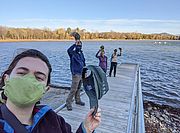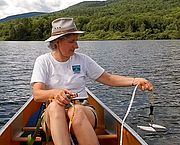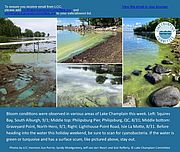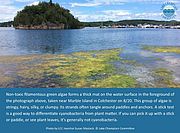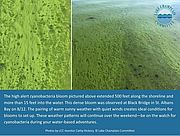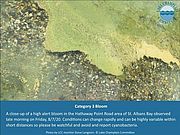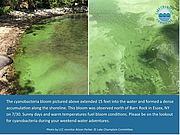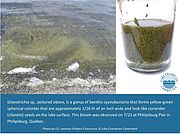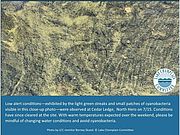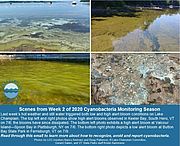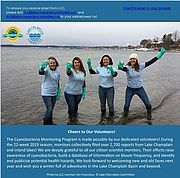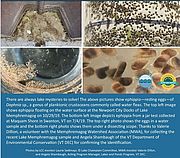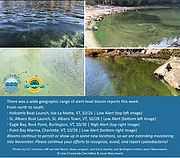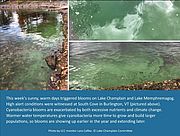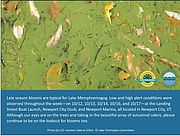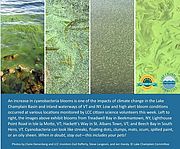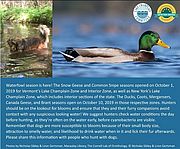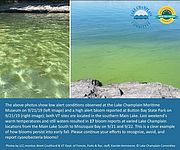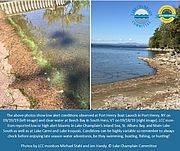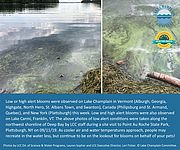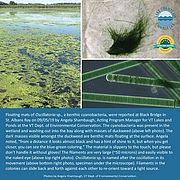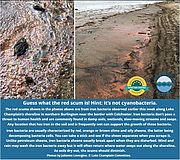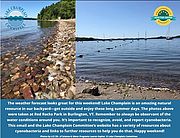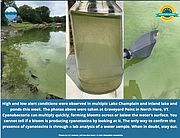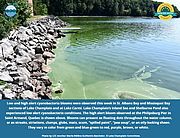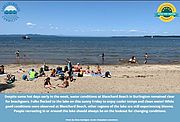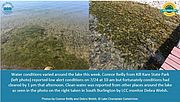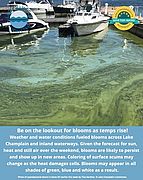We weren’t sure how many people would turn out to monitor during a pandemic that required wearing a mask at public sites and quarantining for two weeks if traveling across state lines. But turn out they did! More than 160 community members signed up to check conditions at over 150 Lake Champlain and inland waterway locations during the 2020 season. They included returning veterans, first-timers, seasonal and year-round residents, couples, families, students, and friend groups. They took on more rigorous protocols, showed up virtually for training sessions via Zoom, and faithfully filed weekly reports. Read...
News from Selected Category
We send heartfelt thanks to Angela Shambaugh, our longstanding cyanobacteria monitoring program colleague who retired in October from the Vermont Department of Environmental Conservation (VT DEC). Angela has been a key partner in the monitoring program since its inception in 2003. In the early years she assisted in lab analysis, cyanobacteria assessments, water sampling, and community outreach while working at the University of Vermont. Read...
While the cyanobacteria tracker map was dominated by green dots last week, too many red dots evidencing blooms are showing as we head into Labor Day weekend. While good conditions were observed at Lake Champlain’s Malletts Bay, Main Lake South, and South Lake and at numerous inland waterways, cyanobacteria blooms showed up in Missisquoi Bay, St. Albans Bay, the Inland Sea, Main Lake North and Main Lake Central on Lake Champlain as well as at Lake Carmi, Lake Morey and Shelburne Pond. Blooms can pop up or persist well into the fall so please continue to check conditions carefully whenever recreating near waterways. Read...
Monitors filed 151 reports this week from Lake Champlain and inland lake sites. The cyanobacteria tracker map shows lots of green dots this week for generally safe conditions. However, blooms are still present in some areas of Lake Champlain and inland lakes. Read...
It’s been a tumultuous week with hot weather, intense rains that flushed nutrients and partially treated wastewater to Lake Champlain, and some high winds that knocked out power. In the midst of it all cyanobacteria monitors collectively filed 212 reports from Saturday August 8 through 1:30 p.m. on Friday August 14! Read...
The Lake Champlain Committee (LCC) and partners received 186 monitor reports last week from August 1 through 4:00 p.m. Friday August 7, 2020. Good conditions were observed in Lake Champlain’s Missisquoi Bay, Malletts Bay and the South Lake while blooms were reported for areas of St. Albans Bay, the Inland Sea, Main Lake North, Main Lake Central, and Main Lake South. Mixed conditions continued in Lake Carmi. Read...
The Lake Champlain Committee (LCC) and partners received 154 monitor reports this past week from Saturday July 25 through 1:45 p.m. Friday July 31. Good conditions were observed in Lake Champlain’s Missisquoi Bay, Main Lake North, Malletts Bay and the South Lake while blooms were reported for areas of St. Albans Bay, the Inland Sea, Main Lake Central, and Main Lake South. Mixed conditions continued in Lake Carmi this week and Lake Raponda also experienced a low alert. Read...
We received 183 monitoring reports last week through Lake Champlain Committee (LCC) Cyanobacteria Monitoring Program from Saturday July 18 through mid-afternoon Friday July 24. Due to the high volume of reports and some technical issues we weren’t able to send you the compilation until today. Read...
It’s been another busy week for the Lake Champlain Committee (LCC) Cyanobacteria Monitoring Program with 152 reports from Lake Champlain and inland lakes from Sunday July 12 through Friday July 17 at 1:30 pm! Good conditions were observed in Malletts Bay and Missisquoi Bay, there was one alert report in Main Lake Central and one in Main Lake North with mixed alert conditions in St. Albans Bay, the Inland Sea, and Main Lake South. Lake Carmi also had cyanobacteria alerts. Read...
Thank you for signing up to receive the Lake Champlain Committee’s (LCC) cyanobacteria monitoring reports! Monitoring will run through the early fall. Each week we’ll send you an update about conditions our monitors are finding around Lake Champlain and several inland lakes. This week’s report covers results from Sunday July 5 through late afternoon Saturday July 11. We had 159 reports that ranged from clear water conditions (perfect for cooling off in) to turquoise blooms that closed down access areas. Future reports will generally be sent to you on Fridays. Read...
Photosynthetic bacteria, gelatin, and concrete are the building blocks of a new type of material: living concrete! Researchers at the University of Colorado, Boulder, funded by the Department of Defense, formed the new substance. Minerals in the concrete are deposited by cyanobacteria; in contrast to the typical greenhouse gas-emitting process required in the production of regular concrete, cyanobacteria absorb carbon dioxide through the photosynthetic process.
Read...Hundreds of LCC-trained volunteers took to the water from mid-June through mid-November to assess conditions at more than 100 Lake Champlain and inland waterway sites. Each week they scoured the shoreline for signs of cyanobacteria, donned gloves and took water samples and faithfully filed online reports.
Read...This is the last report of the 2019 Lake Champlain and Inland Lake cyanobacteria monitoring season. Lake Champlain Committee (LCC) monitors and partners have filed over 2,700 reports from Lake Champlain and inland lakes during a 22-week season. We’re deeply grateful for their efforts. Read...
It’s snowing in the Lake Champlain Valley, coating much of our region in a gentle blanket of white as we enter our last weeks of cyanobacteria monitoring. The cooler temperatures make conditions much less hospitable for cyanobacteria, so not suprisingly, the majority of reports this week were for generally safe conditions. However, the bottom-dwelling cyanobacteria, Nostoc sp., was observed again at Lake Winona earlier in the week. Read...
Cyanobacteria blooms were reported this week from Lake Champlain’s St. Albans Bay, Inland Sea, Main Lake North, Main Lake Central and Main Lake South as well as at Lake Carmi and Lake Memphremagog. Yesterday’s intense rain may wash cyanobacteria out or give them a fresh load of nutrients to grow. While the cooler temperatures will make conditions less hospitable for cyanobacteria, they may still pop up so please use the links and resources in this email to help you recognize, avoid and report blooms. Read...
Blooms were observed this week at a few Lake Champlain locations as well as on Lake Memphremagog. Temperatures are predicted to stay fairly warm into the beginning of next week, so cyanobacteria may continue to show up in waterways. As you enjoy fall’s beauty in the watershed, please keep a close eye on the water and use the information and links in this email to learn how to recognize, avoid, and report cyanobacteria. Read...
Blooms were experienced this week in Lake Champlain’s St. Albans Bay and Main Lake North, as well as Lake Carmi and Lake Memphremagog. We’ve had a blustery few days, with strong winds triggering lots of wave action on our waterways. In addition to breaking up existing surface accumulations, the windy weather and power outages also affected some monitors’ ability to report. Read...
We had some great weather for leaf peeping this week but unfortunately, those moderate temperatures and sunny, calm days also helped cyanobacteria blooms flourish. High alert or mixed conditions were witnessed in Lake Champlain’s St. Albans Bay, the Inland Sea, Malletts Bay, Main Lake North, Main Lake Central and Main Lake South as well as in Lake Carmi and Lake Memphremagog. Read...
As temperatures cool and hues of orange, yellow and red color the hillsides, we hope you are enjoying autumn’s beauty. Although blooms are less likely as air and water temperatures drop and frost warnings are in effect, cyanobacteria can still persist or pop up. While there were plenty of reports of clear water this week, blooms continued to show up in Lake Champlain and an inland waterway. Read...
Unseasonably warm weekend weather triggered a spate of 17 bloom reports on 9/21 and 9/22. More blooms followed during the week, with some monitors reporting their first blooms of 2019. With temperatures predicted to rise into the 70s on Saturday, we anticipate some blooms will continue to persist for a while and that cyanobacteria may pop up in new locations. Read...
Today marks the global climate strike followed by a week of events to highlight the urgency of climate action. Water is a primary medium through which we feel the effects of climate change. Declining water quality is another consequence of a warming planet. As air temperatures rise, so too do water temperatures. Read...
Mixed conditions were reported again this week on Lake Champlain in Missisquoi Bay, St. Albans Bay, and the Inland Sea, and also at Lake Carmi. The floating mats of the benthic cyanobacteria Oscillatoria sp. that we showed you pictures of last week were still present at Black Bridge in St. Albans Bay on 9/10/19, but to a lesser extent. Monitors also observed mixed conditions in the Main Lake North section of Lake Champlain. Read...
Kids are back at school, seasonal staff are leaving beach and park areas, and there’s a hint of fall in the air this first week of September. However, cyanobacteria can still flourish even when autumn colors begin to show on the hillsides which is why the Lake Champlain Committee Cyanobacteria Monitoring Program continues through the end of October. Read...
It was another busy week for <link about-lcc>Lake Champlain Committee (LCC) monitors with alert level conditions reported from Lake Champlain’s Missisquoi Bay, St. Albans Bay, Inland Sea, Main Lake North, Main Lake South, and South Lake. Cyanobacteria was also reported at Colchester Pond, Lake Carmi, Lake Memphremagog, Nichols Pond, and Shelburne Pond. Bulwagga Bay Beach in Moriah NY was closed on Sunday August 25 due to a bloom but has since re-opened. Read...
We hope you’ve been enjoying the cooler temperatures and lower humidity this week. Here are results from our tenth week of the Lake Champlain Committee (LCC) cyanobacteria monitoring program. You’ll find resources and links to help you identify, report and avoid cyanobacteria. We’ve also included pictures of some of the conditions observed this week along with photos of a stick test you can use to help you differentiate cyanobacteria from non-toxin producing green algae. Please continue to share these resources with others to help educate people on water issues.
Read...
Alert level conditions were reported from several Lake Champlain locations and inland lakes this week including Lake Champlain’s inland sea, St. Albans and Missisquoi Bays and at Indian Brook Reservoir, Lake Carmi and Shelburne Pond. Scattered storms are predicted for the weekend before a rise in temperatures next week so pease be on the lookout for blooms and avoid contact with anything that looks suspicious. Read...
While there were many reports of generally safe conditions this week several sections of Lake Champlain as well as some inland waterways continue to be plagued by mixed conditions. Read LCC's latest report on cyanobacteria conditions for the week of 8/4/19. Read...
Lake Champlain Committee Monitors filed 177 reports this week! Blooms appeared in four Lake Champlain regions: Missisquoi Bay, St. Albans Bay, Inland Sea, and Main Lake Central. There were also bloom conditions at Lake Carmi and Shelburne Pond. Warm weather is predicted for this weekend. Please be on the lookout for blooms and avoid contact with anything that looks suspicious.
Over 216 reports were filed this week from Lake Champlain and inland waterways. Blooms were observed in all regions of Lake Champlain, except Malletts Bay and South Lake; Lake Carmi also had reports of cyanobacteria. Sun and heat are in the forecast for Saturday—be on the lookout for blooms!
Lake Champlain Committee monitors filed over 196 reports this week for Lake Champlain and inland waterways. While there were plenty of reports of clear water, blooms proliferated in parts of Missisquoi Bay, St. Albans Bay, the Inland Sea, Main Lake Central and Main Lake South. Shelburne Pond and Lake Carmi also had reports of cyanobacteria. Several beaches were closed in both New York and Vermont.

